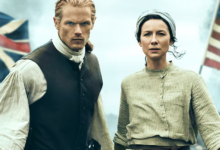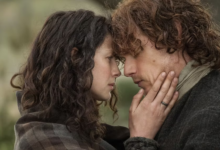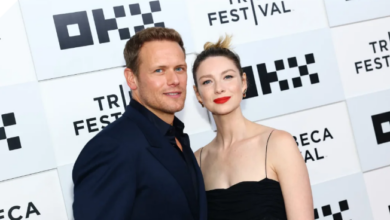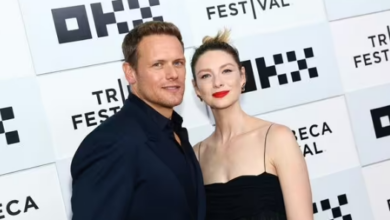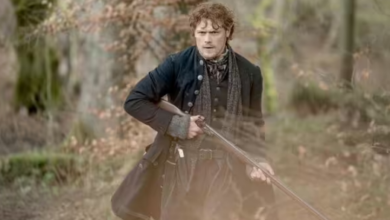Even 7 seasons in, Outlander’s core love story is still setting the bar for romance
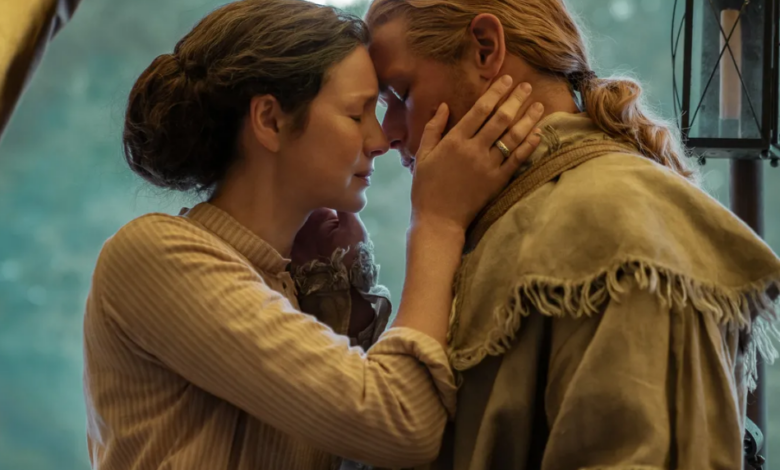
Outlander walked so shows like Bridgerton could run
“Don’t“Don’t be afraid. There’s the two of us now,” may be one of the most romantic lines ever written, but when Outlander author Diana Gabaldon penned it, it’s doubtful she realized how much of an anchor it would become not just for her main characters, but for their millions of fans.
Since the book series debuted in 1991, Outlander has amassed a huge fan base obsessed with its prestige historical drama and fantasy elements, but the thing that keeps people coming back is its romance. Gabaldon has planned 10 books for the series, and the penultimate door stopper — the ninth book, Go Tell the Bees That I Am Gone — debuted at No. 1 on the New York Times bestseller list in 2021. The core series, not including the Lord John Grey spinoff series or the novellas and companion books, boasts nearly 9,000 pages total — and the element holding it all together is the sweeping, impossible love story between protagonists Claire and Jamie Fraser.
Thanks to the Starz television adaptation, which is currently in part one of its two-part seventh season, Outlander is more popular than ever. Eight months prior to the show’s debut in 2014, Outlander made the NYT bestseller list for the first time in 23 years on shelves, and Gabaldon’s other new releases in the last decade have seen incredible success as a result of the TV series. Older seasons are available on Netflix, and Starz frequently runs deals on its own streaming app with Outlander as one of its main selling points to gain new subscribers.
In many ways, Outlander sets its own precedent as it seeks to legitimize itself through prestige presentation, leaning into and highlighting its various genres — particularly romance — rather than shying away. In the first episode, Claire Randall (née Beauchamp, played by Caitríona Balfe) accidentally travels from 1945 to 1743 through a stone circle and meets James Alexander Malcolm MacKenzie Fraser (Sam Heughan), her canonical soulmate and true love.

The fantastical aspect of Outlander just makes the love story even more profound. Claire and Jamie are separated by two centuries, multiple wars, more than a handful of near-death experiences, and brutalities, including multiple occurrences of sexual assault. There’s also Claire’s determination not to change the future for her first husband, Frank Randall (Tobias Menzies), whose direct ancestor is nothing like the noble soldier Frank imagines him to be but instead spends his years hunting and torturing Jamie and, eventually, Claire. Being a woman out of time makes things complicated for Claire, whose knowledge of the future and occupation as a wartime nurse and eventual surgeon lands her in the particularly hot waters of more than one witch hunt. Luckily, when she tells Jamie where she comes from, he believes her, as do the loved ones with whom the couple chooses to share the truth.
No matter the obstacle, Jamie and Claire find a way to go around or through it in order to be together. Their inconceivable romance provides the ultimate escape for viewers and readers alike. Each change is catered toward deepening the relationship between Jamie and Claire, whether it tightens their inner circle or creates new moments of connection, such as when the ring Jamie gives Claire in Gabaldon’s novels makes an appearance after her first ring — smelted from the key to Jamie’s ancestral home — is stolen in season 4. Moments like these not only highlight important book moments that fans want to see on screen, but they show how the couple invests in each other in both big and small ways, and how those moments are valued in the story too. Unlike longtime marriages that become less passionate as partners age, Claire and Jamie seem to always be falling deeper in love.
The romantic and sexual chemistry between Balfe and Heughan is palpable every time they share the screen, somehow making even the schmoopiest moments feel realistic. Outlander eschews secondhand embarrassment for its viewers at every turn, refusing to degrade so-called bodice-rippers in favor of the other genres explored in the story. Sex scenes are given as much care and attention to detail as plot-heavy or wartime scenes, and each episode stays grounded in the core relationship to drive the story forward without ever breaking their connection — even when Claire returns to her present and the pair are separated for two decades. Fans are able to get as invested in Claire and Jamie’s love story as they desire, with the sure knowledge that come what may, the couple will always find their way back to each other.
In the same way Peter Jackson’s Academy Award-winning Lord of the Rings trilogy, HBO’s Game of Thrones, and other fantasy series sought to establish the genre as being worthy of the same accolades as prestige dramas, Outlander attempts to prove that the romance genre deserves more respect than it gets. Traditionally written off as “chick lit,” romance — especially erotic romance — has garnered a reputation as trashy pulp fiction that’s formulaic and unserious. Not only is this classification wildly disrespectful to romance authors, but it also alienates and degrades readers whose tastes skew toward stories with happy endings between romantic partners. Even personal expression of that, like fanfiction (which is largely written by young women), is mocked for its frequently romantic overtones. (And none of this even accounts for stories that explore healthy BDSM and kink, which are equally valid and deserve recognition.)
Also like its contemporaries, Outlander takes place in a world where sexual violence is a constant threat, though it handles the issue in a noticeably less exploitative way. Outlander examines sexual violence against men and digs into the lasting psychological, emotional, and physical tolls of such trauma on people of any gender. It isn’t the only danger these characters face, and each instance is handled with the appropriate severity and consequences. Claire and Jamie grapple with it as individuals and as a couple, as do other characters and their partners, making it feel less like it’s written for shock value. Although it’s horrifying to witness these moments of violation, there’s some comfort in seeing how the characters prioritize healing and communication with each other, strengthening their bonds rather than ignoring what’s happened and losing sight of each other. Romance can survive — and thrive — even in the bleakest of narratives.
Without Outlander, in spite of its imperfections, subsequent romance series like Netflix’s Bridgerton adaptation might not have happened. Certainly, many series before and since Outlander have featured love stories, but few have come straight from schmoopy, swoony, escapist romance novels and been adapted for screen with any kind of seriousness. The simple fact that it took more than 20 years for Outlander to become a TV series is evidence enough that when it comes to long-form romance stories, buy-in is harder to achieve — but if creators care for and stay true to a love story, it can leave a massive impact. After all, Jamie and Claire are well into their 50s in the current season of Outlander, and their romance is as alive as it always was, for fans old and new.
